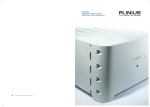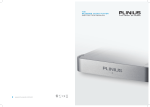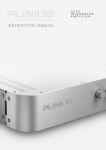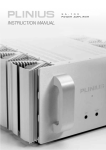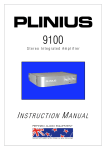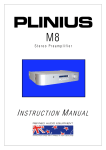Download Audible Technologies PLINIUS 9200 Instruction manual
Transcript
9200 I N T E G R AT E D A M P L I F I E R INSTRUCTION MANUAL www.pliniusaudio.nzld.com Contents Introduction ...............................................................................................................2 Design Philosophy ...............................................................................................3 Unpacking ....................................................................................................................4 Placement & Ventilation ....................................................................................4 Care & Maintenance............................................................................................5 Precautions ................................................................................................................6 Front Panel Functions ........................................................................................7 Rear Panel Functions .........................................................................................8 Installation & Operation ....................................................................................11 Product Features ..................................................................................................15 Loudspeaker Selection .....................................................................................17 Troubleshooting .......................................................................................................18 Specifications ..........................................................................................................19 Index ................................................................................................................................20 All operational, technical and descriptive material in this publication is subject to change at any time without notice. For further product information or queries, please contact your Plinius dealer. Plinius products are designed and manufactured by Plinius Audio Limited, New Zealand. 1 Introduction Congratulations on your decision to become the proud owner of this Plinius 9200 Integrated Amplifier. This manual has been prepared to help you understand the operation of your amplifier, and to provide information about its design and the variety of ways it may be used. We have designed and manufactured this amplifier to reproduce your favourite music faithfully and accurately. With a little care and a full understanding of the operating recommendations in this manual, your Plinius 9200 Integrated Amplifier will provide years of high-quality, trouble-free performance. Please take the time to read this manual thoroughly before using your amplifier. SERIAL NUMBER FINAL TEST CERTIFIED BY 2 Design Philosophy From a distance you can see that the design of the Plinius products is more than an applied styling exercise to the front panel. We have started from the ground up to produce a casing for our electronics that is unrivalled in its physical strength and visual simplicity. Wherever possible we have reduced the number of parts needed and then invested massively in refining and producing the remaining parts to the highest quality achievable with state of the art computer controlled machines allied with expert craftsman. Examples of this approach include the hydraulically formed corners on the amplifiers giving much greater strength and the one piece housing for the remote control that looks, feels and genuinely is robust. As with music that you are not familiar with, truly innovative new designs can take time to understand and enjoy. How often have you heard music that you were first unsure of, that over repeated listening, has become a firm favourite? Our designs are fundamentally different to many other companies, and we hope that you will take the time to explore their unique character and qualities because we have not made them different simply to be different. We genuinely believe that their visual and tactile qualities do improve the experience of listening to music and that is our design goal! Ross Stevens DESIGN DIRECTOR 3 Unpacking Open the box from the top and remove the accessories from the foam end caps. You may now proceed to lift the unit from the box, Once the unit is removed you can proceed with the removal of the foam end caps. These caps are designed to fit on the front and back of the unit for maximum protection. Retain the packaging for future transportation of this unit. Placement & Ventilation Your Plinius 9200 may operate at a moderately high temperature, especially during extended listening sessions. The ideal location is upon a rigid stand, away from direct contact with any temperature sensitive materials, furniture or deep pile carpets. Ventilation through and around the amplifier should also be kept unimpeded. Please ensure that the heat vents (slots in the base and lid) are not covered or restricted in any way. The Plinius 9200 design incorporates a very high level of mechanical decoupling of the input and output. It can however still be influenced by acoustical feedback in the operating environment. The use of acoustic cones or a suitably spiked amplifier stand or table may further enhance the performance of this preamplifier. Consult your Plinius dealer for further advice if required. 4 Care & Maintenance With simple care and maintenance your Plinius product can be kept looking and operating like new for many years to come. MAINTAINING THE CONNECTORS Exposed connectors such as the RCA connectors will be subject to environmental factors, and over time the surface may degrade. This can be greatly reduced by fitting readily available ‘RCA caps’ to reduce the effects of environmental elements on the RCA connectors. These RCA caps or RCA shorting caps can also provide sonic benefits. Connector cleaning products are also available to clean the RCA and cable connectors and frequent checks and cleaning will help maintain a good signal connection. NOTE: DO NOT use RCA shorting caps on output connectors or power amplifier input connectors. Use RCA shorting caps on unused preamplifier stage input connectors only. Standard RCA shielding caps can be used on any unused input or output connectors. MAINTAINING THE SWITCHES Switches should be maintained by using each various switch setting periodically. Even if a switch or a switch setting is not used, it is a good idea to toggle small switches and turn rotary switches though the full range of the switch several times in succession to keep the contacts active. Performing this simple action will promote longevity of the switch contacts. SURFACE CLEANING From time to time you may wish to clean the surface of your Plinius equipment to remove dust, or any material build up from the atmosphere or on commonly used controls. Your Plinius product is made up of parts that have a hard anodised or a powder coat finish and will clean easily without being damaged. Cleaning should be carried out using a soft cleaning cloth, dry or with either a small amount of water or a very mild surface cleaner, while observing the following guidelines: As a safety precaution, always switch the equipment off prior to cleaning Always use a cloth that is soft and clean Never use abrasives or polishing compounds anywhere on the unit Never apply liquid directly to the surface of the unit Use the cloth dry or with mild surface cleaners of either liquid or foaming type Apply only small amounts of cleaner to the cloth DO NOT rub the surface but wipe clean only. Excessive rubbing may dull powder coat or wear the screen printed text. 5 Precautions PLEASE TAKE SPECIAL NOTE OF THE FOLLOWING PRECAUTIONS BEFORE OPERATING YOUR NEW AMPLIFIER. The Plinius 9200 Integrated Amplifier can deliver in excess of 200 watts into 8 ohms. This amplifier is also capable of a very large peak current delivery. The Plinius 9200 Integrated Amplifier operates in Class AB. It is capable of generating heat that could have an adverse effect on other electronic equipment, furniture, etc. DO NOT leave flammable material on the amplifier whilst running, as this could pose a serious fire risk. This amplifier operates at hazardous voltage levels. There are some alterations that may be made by you, the owner. However, we recommend that any work requiring removal of the lid be referred to a suitably qualified and experienced service technician. DO NOT attempt to connect any input of this amplifier to its own outputs. DO NOT earth any output terminal or connect any of these terminals together without following the instructions in this manual or seeking qualified assistance. DO NOT place this amplifier in any position where liquids, or any foreign material may accidentally enter it. DO NOT connect any voltage source, short circuit, earth/ground or appliance (other than suitable high fidelity loudspeakers) to the amplifier output terminals. 6 Front Panel Functions The front of the Plinius 9200 Integrated Amplifier incorporates all the facilities you will require on a daily basis. 2 3 4 1 1. DISPLAY LED An LED on the front panel indicates that the power is on. When first switched on, the display LED will vary in brightness until the initialisation sequence is completed, after which the LED remains lit. Whenever mute or a remote button is pressed, the LED will dim. 2. RECORD SELECTOR This rotary switch allows recording of any of the five different inputs. Note that when recording, the source that is being listened to will not be interfered with. This allows for listening to the one input whilst recording from another input. Two recording devices can be connected and dubbing in either direction is possible. Note that in standby mode no input is selected. 3. SOURCE SELECTOR This rotary switch enables selection of any of the five different inputs available on the back panel. This selection is fed to pre out terminals and the speakers via the output posts on the rear of the amplifier. Note that in standby mode no input is selected. 4. VOLUME CONTROL The volume control is an ALPS motorised unit that will accurately convey the source signals to the power amplification stage of the Plinius 9200. The volume can be adjusted manually or with the remote control supplied. When using the remote control to alter the volume level, briefly press the button to make small adjustments, or hold the button down to continuously adjust the volume. 7 Rear Panel Functions This panel incorporates all terminals for connecting the input signals from your CD player, tuner, etc and the outputs to the loudspeakers and mains supply. Please remember that your Plinius 9200 Integrated Amplifier is a high quality electronic instrument capable of an exceptional level of performance. Be sure that you understand your system’s requirements fully before you make any connection to this amplifier. 10 7 2 1 6 14 6 9 11 5 5 4 13 8 12 3 1. MAINS SWITCH The heavy-duty rocker switch in the centre of the panel turns the Mains/Line Power to the amplifier ON or OFF. The amplifier draws a moderately high current when switched on, so it is not good practice to rapidly turn the Mains switch on and off repeatedly. 2. INPUT TERMINALS The input terminals for your Plinius 9200 Integrated Amplifier are easily accessible along the top of the rear panel, with the right (red) inputs along the top. The phono inputs are suitable only for low level input phono turntables, while the rest are all ‘line level’ inputs, for use with unbalanced signals from line level source components such as CD players, tuners, etc. There are also two tape input loops for recording and playback. Consult your Plinius dealer for further advice if required. 3. CD XLR INPUT TERMINALS Below the CD RCA inputs are an additional set of ‘line level’ XLR balanced inputs for use with source components that feature XLR balanced outputs. Balanced signals are carried via a three way cable. The XLR pin configuration used in all Plinius product is: PIN 1 to GND PIN 2 to +Signal PIN 3 to -Signal NOTE: Because of the way our XLR and balanced inputs are configured it is not possible to use both XLR and RCA at the same time. 8 4. INPUT SELECTION SWITCH This switch directly below the ‘TAPE 1’ input is used to select the pair of CD input sockets required as described above. Up selects the CD RCA input connections, while down selects CD XLR input. 5. OUTPUT TERMINALS Connections for the loudspeakers are provided on the right hand side of the rear panel. Two parallel pairs of five way binding posts for each channel are fitted – these provide ease of use with bi-wiring and multiple cables requiring a large contact area. 6. TAPE OUTPUTS These RCA outputs are situated next to the tape RCA inputs, and are provided to interface to a pair of line level recording devices. The position of the record selector on the front panel determines from which device a recording is being made. As these tape outputs are always ‘live’, both can be used to record the chosen signal at any time. 7. MUTE SWITCH The mute switch enables muting of the preamplifier, without the need to use the remote control. When the amplifier is in mute, the LED on the front panel will dim. NOTE: Mute does not disconnect the outputs. 8. GROUND LIFT SWITCH This switch allows the signal ground to be disconnected from the chassis. In some installations a hum loop may exist due to duplicate ground paths from different equipment. Use this switch to remove the connection from 0V to ground thus allowing some flexibility in your particular set-up. 9. PROCESSOR SOURCE AND RETURN These RCA connections are for use with a multi-channel sound processor. They are provided so that you can use the Plinius 9200 as either two channels in a multichannel environment, or to send signal through the 9200 to an external processor. Refer to the ‘Installation & Operation’ section on page 11 for more information. 10. PROCESSOR SWITCH This switch is used in conjunction with the processor source and return terminals, and controls whether the amplifier is used via the normal inputs or the processor return input. 11. PRE OUT OUTPUT The Pre-Out connection is provided to enable the Plinius 9200 to be connected to an external power amplifier. 9 12. MAINS POWER CORD IEC SOCKET This connector is where the mains supply cable from your wall connects to the amplifier. You will notice that a fuse holder is mounted within this connection, and it holds a mains fuse to provide surge and overload protection for your amplifier. 13. RAIL FUSES These tubular fuse holders house the positive and negative rail protection fuses. Depress and turn anti-clockwise to open. An LED is fitted next to each fuse holder and will illuminate to indicate a blown fuse. 14. PHONO EARTH POST This is a chassis connected gold-plated earth post for use with most vinyl turntables. 10 Installation & Operation WARNING: RISK OF ELECTRIC SHOCK This amplifier operates at hazardous voltage levels. We recommend that any work requiring removal of the lid be referred to a suitably qualified and experienced service technician. DO NOT place this amplifier in any position where liquids or any foreign material may accidentally enter it. PLEASE READ & UNDERSTAND THE PRECAUTIONS WITHIN THIS MANUAL FOR PLACEMENT & OPERATION OF THIS PRODUCT. MAINS VOLTAGE CONNECTION Firstly, check that the mains supply voltage printed on the rear of this amplifier is similar to the mains supply voltage in your area. If in doubt, please consult your Plinius dealer. Mains supply power connection is via the supplied plug-in lead. A standard IEC socket connects the mains power at the amplifier end, while a local mains plug is required at the wall end. The wiring code used inside all Plinius product is: Green to Earth/Ground Blue to Neutral Brown to Phase/Live Should a ‘local’ plug need fitting to the wall end of the lead, ensure that a suitably qualified service technician wires the plug correctly. DO NOT POWER UP YOUR AMPLIFIER UNTIL YOU HAVE CONNECTED YOUR INPUT/OUTPUTS CORRECTLY FOR YOUR SYSTEM. CONNECTIONS Connections to your Plinius 9200 should be made in the same order as they are listed in this section. DO NOT attempt to connect your Plinius 9200 until you have read and fully understood these instructions. Should you require further assistance, please contact your Plinius dealer. SOURCE COMPONENT INPUTS Connect your Source to the input of the Plinius 9200 using suitable single-ended RCA or Balanced XLR interconnect cables only. For RCA, make sure you connect the red coded cable to the red RIGHT RCA input, and the black (or white) cable to the black 11 LEFT RCA input. Also make sure the RCA connectors are a snug fit and are inserted all the way in. For CD XLR input connection, make sure you connect the RIGHT XLR input and LEFT XLR inputs to the right and left outputs from your source respectively. Also make sure the XLR connectors click into place. Use the input selection switch to select RCA if you are using RCA inputs or to select XLR if you are using XLR inputs. NOTE: DO NOT connect XLR and RCA at the same time, use only one or the other. The phono input should be connected to a suitable source turntable only. LOUDSPEAKER OUTPUTS The connection of your loudspeakers to the output posts of the Plinius 9200 must be made by an ‘instructed person’ with suitable ready made loudspeaker cables only. Connect your left loudspeaker (ie. the one on your left when seated in your normal listening position) to the left output terminals. Ensure the terminals on the amplifier are connected to the loudspeaker terminals Red positive (+) to Red positive (+) and Black negative (–) to Black negative (–). Repeat this process for the right outputs. TERMINATION QUALITY Quality of the connections must be examined to ensure that high-performance, trouble-free operation is enjoyed. Check that the connections are tight but do not over tighten. If bare wires are used make sure that no loose strands of wire short across the other terminals or the amplifier chassis. When using plugs such as bananas, be sure to use good quality plugs with a firm fit. BI-WIRING Bi-wiring uses two pairs of loudspeaker cables for each channel loudspeaker. You will notice that the rear panel of your Plinius 9200 has two pairs of output terminals for this purpose. When bi-wiring, always connect the terminals positive (+) to positive (+) and negative (–) to negative (–). Be sure to remove any jumpers that may be fitted to your loudspeakers. PHASING (OR POLARITY) It is important to achieve good stereo imaging in your listening room. By observing the wiring instructions above, each power amplifier/loudspeaker combination should be in phase. If you experience poor stereo image and/or a lack of bass, check that the loudspeaker wiring has been connected correctly. If in doubt, consult your Plinius dealer for advice. Naturally it is also important to make sure all the leads carrying signals for the RIGHT channel loudspeaker are connected to the RIGHT input to the amplifier from your preamplifier or CD player etc. Signals for the LEFT channel should be wired in a similar fashion. 12 RECORDING MUSIC In order to record music to tape, or similar line level recording device, these devices will need to be connected to the tape 1 and tape 2 outputs. Turn the record selector on the front panel to the input you wish to record from, and the amplifier will now send signals to both tape 1 and tape 2 outputs. Note that the volume control does not adjust the recording level – this is done at the recording device itself. CONNECTING A HOME THEATRE RECEIVER OR PROCESSOR The power amplifiers of the Plinius 9200 will most likely perform better sonically than the amplifiers in your home theatre receiver. The Plinius 9200 rear panel processor connections allow you to take advantage of this. Processor Source is a preamplifier output from the 9200. The 9200 volume control can be used to set the level to the processor input, and allows a source component connected to the 9200 to be played through the processor without changing cables. Note: Connect the 9200 Processor source to a line level processor input only. Processor Return is an input to the 9200 power amplifiers. This allows two channels of the processor’s preamplifier to use the high quality power amplifiers of the 9200. The volume when using the processor return input is adjusted at the processor. NOTE: Connect the 9200 Processor Return to a suitable processor pre-out only. To use Processor Return input, toggle the processor switch on the rear panel of the 9200 to ‘In’. To return to using the 9200 as normal toggle the processor switch to ‘Bypass’. No other input to the 9200 is accessible in ‘Processor In’ mode. The Processor source output is live at all times with the signal of the input selected on the 9200. USING PRE OUT A line level output is provided on the back of the Plinius 9200. If you wish to use the Plinius 9200 as a pre-amp only, or to send signal to another amplifier, fit the interconnect cable to the pre out outputs. The signal from this output is preamplifier out level, and as such is not amplified by the power stage of the Plinius 9200. The output level remains adjustable by using the volume control. Note that the pre out connections provide signal from whatever the source selector knob is currently set to. CONNECTING THE MAINS SUPPLY Firstly, check that the mains supply voltage printed on the rear of this amplifier is similar to the mains supply voltage in your area. If in doubt, please consult your Plinius dealer. Mains supply power connection is via the plug-in lead supplied with your Plinius 9200. Where possible, check the wall outlet is switched OFF, then connect the local mains plug end of the lead to the wall outlet. Check the 9200 is switched OFF, and connect the IEC end of the cable to the IEC socket at the back of the 9200. With the cord fully connected, switch the wall outlet ON. 13 Now that your Plinius 9200 is configured correctly, switch the power switch on the rear panel to ON. The display LED will cycle in brightness for approximately ten seconds as the internal circuitry stabilises. You can now enjoy your new Plinius 9200 Integrated Amplifier. NOTE: This unit must be connected to a mains socket outlet with a protective earthing connection. The wall outlet socket or mains switch must be accessible at all times in case of emergency. WARM-UP PERIOD You will find that the Plinius 9200 will become noticeably ‘purer’ in sound after being on for a period of time. We usually recommend waiting at least 24 hours before expecting the best quality of sound reproduction from your amplifier. Also, as the Plinius 9200 uses very little power while on, we suggest leaving the unit turned on so that it will always be at its sonic best. 14 Product Features REMOTE CONTROL Provided with your Plinius 9200 is a three function remote control. The two buttons at the top of the remote adjust the volume level, and the button below switches the amplifier in and out of mute. Two AAA batteries power the remote, and these are replaced by removing the two screws on the base of the remote that hold the battery compartment in place. The bottom end of the remote is now free to slide out for access to the batteries. Replace the two batteries, taking care to refit the new ones with correct polarity. PHONO GAIN ADJUSTMENT The phono stage can also be set to high or low gain to suit your phono turntable specifications (high gain is the factory setting). Disconnect the lead from the IEC socket on your Plinius 9200 and make sure the Mains switch is OFF. Carefully remove the lid by undoing the cap screws on the top and side. Locate the small black phono jumpers to the middle-right side of the top circuit board. The gain can now be adjusted noting that high gain (factory setting) is set with jumpers to the left, and low gain is set with jumpers to the right. Now re-assemble your Plinius 9200. TAPE LOCKOUT PROTECTION On most tape decks, any signal recorded is sent to the tape outputs so that the signal level of the recording can be monitored. Should the user accidentally try to record the tape decks own output, feedback noise usually results. The Plinius 9200 Tape Lockout feature is designed to prevent this situation and will also prevent excessively high source component signals from reaching the output, which may cause damage to the speakers. When tape lockout protection occurs, the amplifier outputs will be momentarily disconnected and the power LED will be dim and flash. NOTE: If you find tape lockout protection is activating during a normal listening session, or due to a ‘loud’ recording, turn the record selector to standby. Tape lockout protection only functions when record and source are set to the same input. FUSE PROTECTION When any rail fuse is damaged one or more fuse warning LED’s will light. These LED’s are located next to the fuse that has blown. To replace the fuse, disconnect the amplifier from the mains power and wait 30 minutes, then firmly push in the round fuse cap with your fingers. When the cap cannot push in any further, rotate the cap anticlockwise (to the left) until it comes to a stop. Release inward pressure on the fuse cap and it can now be removed from the amplifier. Replace them with the same type only. To re-fit the fuse, insert the fuse and gently turn it as far as possible anti-clockwise (to the left). Now push the fuse cap in firmly, then turn clockwise (to the right) until it comes to a stop. Release inward pressure on the cap and the fuse will be fitted securely. 15 IMPORTANT: DO NOT FIT A FUSE WITH A HIGHER RATING. NOTE: that fuse failure may indicate a severe problem. Check all speakers and speaker cables for damage etc. Should the amplifier continue to exhibit rail fuse failure, contact your Plinius dealer. MAINS/LINE FUSE A Mains/Line fuse is fitted within the IEC socket on the rear of the amplifier. A small drawer at the bottom of this socket may be removed (after the IEC plug is removed) by levering it out with a flat blade screwdriver. The fuse fitted should be rated as specified on the rear panel. IMPORTANT: DO NOT FIT A FUSE WITH A HIGHER RATING. In the unusual event that this fuse should blow, you must first establish the cause of this failure (such as power surges, damaged mains cable, etc) before replacing the fuse with one of the same rating and type. Should the amplifier continue to suffer mains fuse failure, contact your Plinius dealer. OVER TEMPERATURE PROTECTION The Plinius 9200 is fitted with an auto-reset thermal sensor. The sensor is located at the main power transformer and should the transformer internal temperature exceed 110°C (230°F) the power will be disconnected from the unit. The unit will remain off until the temperate has reduced significantly, and then the sensor will automatically reset to the ON state. If Over Temperature Protection occurs you should switch the unit off immediately. Check the placement of the unit and ensure there is adequate airflow above and around the unit. Refer to the Placement & Ventilation section on page 4 for further information. 16 Loudspeaker Selection Your Plinius 9200 Integrated Amplifier is designed for use with high fidelity loudspeakers. It should not be used to operate with any other type of appliance or equipment. Be certain that your loudspeakers can handle most of the rated output power of this amplifier. You may find loudspeaker specifications confusing or misleading, so you should discuss this with your audio dealer prior to purchase. As a general rule, the use of high power (200 Watt RMS or greater) loudspeakers is recommended and desirable. However, our experience indicates that medium to low power loudspeakers (100 to 200 Watt RMS) are quite often suitable for use on this amplifier, provided the volume is maintained at a level where no distortion is audible. Impedance of the loudspeaker load is important to ensure the rated performance of this amplifier. If you have doubts about the impedance of your loudspeaker configuration, we recommend you speak to your Plinius dealer. 17 Troubleshooting NO SOUND FROM THE UNIT If the unit is not reproducing audio take the following steps: Check the source is correctly connected to an appropriate input on the unit. Refer to the Installation & Operation section on page 11. Check the source is playing, and not paused or muted. If it has adjustable volume, check this is at the usual output level. Check the unit is set to select the correct source input. Adjust the ‘Source’ selector for the correct source component. Check the volume. Turn the unit volume up to a point just below the normal listening level. DO NOT turn the volume up to maximum in case the sound begins to come through the speakers. Check the unit is not in Mute. If the Display LED is dim, this indicates the unit is in Mute mode. The Display LED should be full brightness for operational mode. Check the processor switch setting. This must be set to ‘Bypass’ (towards the Speaker outputs) when using source components connected to the unit. Set Processor Bypass to ‘ON’ for listening to sources via the processor or home theatre equipment. UNIT GOES INTO ERROR MODE If the input signal exceeds the set level, an Error mode is activated by the tape lock out feature and will cause the unit to go into Mute to protect recording devices. This Error mode is displayed by the power LED being dim brightness and flashing on and off. If the tape lockout is activating often or under normal conditions it can be overridden by setting the ‘Record’ selector to ‘Standby’. SOUND IS QUIET OR DISTORTED If the sound is quiet or distorted a rail fuse may have failed. While the unit is ON check the fuses in the rear panel. A Red LED being on will indicate a fuse failure. If the fuse has failed, see Fuse Protection in the Product Features section of this manual. NOTE: If the unit immediately or repeatedly suffers rail fuse failure, there may be a major problem and you should contact your Plinius dealer. POWER FAILURE The unit may have suffered mains fuse failure or be in thermal overload protection mode. Mains Fuse Failure: Check the mains fuse and replace if needed. Thermal Overload Protection: Assess the temperature of the unit. If the unit seems excessively hot, the Over Temperature Protection may have activated. Refer to the Product Features section on page 15 for further information. NOTE: If the unit immediately or repeatedly suffers mains fuse failure or thermal overload protection, there may be a major problem and you should contact your Plinius dealer. 18 Specifications POWER 200 watts RMS per channel into 8 ohms. 280 watts RMS per channel into 4 ohms. Both channels driven from 20Hz to 20kHz at less than 0.2% total harmonic distortion FREQUENCY RESPONSE 20Hz to 20kHz +/–0.2dB –3dB at 5Hz and –3dB at 70kHz DISTORTION Typically <0.05% THD at rated power 0.2% THD and IM worst case prior to clipping CURRENT OUTPUT 40A short duration peak per channel Fuse protected SLEWING 50V/µs HUM & NOISE 90dB below rated ouput 20Hz to 20kHz unweighted GAIN Line inputs to speaker out: 40dB Phono Input To Pre-Out: 66dB on high gain, 60dB on low gain INPUT IMPEDANCE 47k ohms all inputs INPUT OVERLOAD 5V RMS RATED PRE OUT LEVEL 1.5V RMS into 47k ohms or higher PRE OUT SOURCE IMPEDANCE Typically 1.5k ohms PRE OUT MINIMUM RECOMMENDED LOAD 47k ohms TAPE OUTPUT LEVEL 190mV at 200 ohms Tape loop muting at 5V RMS input POWER/CURRENT CONSUMPTION 600VA 0.4A (92W) Class AB Idle DIMENSIONS Height: Width: Depth: Weight: 120mm 450mm 400mm 14kg (4.75’) (17.75’) (15.75’) (30lbs) 19 Index Bi-wiring .........................................................................................................12 Front Panel Layout ...............................................................................7 Fuse Protection .......................................................................................15 Ground Lift Switch ................................................................................9 IEC Power Connector ........................................................................8, 13 Input Terminals ........................................................................................8, 11 Loudspeaker Impedance ..............................................................17 Loudspeaker Power ............................................................................17 Mains/Line Fuse .....................................................................................15 Mains Supply Connection .............................................................13 Mains Switch .............................................................................................8 Mute Switch ................................................................................................9 Operating Temperature....................................................................4 Output Terminals ...................................................................................9, 12 Over Temperature Protection ......................................................16 Phasing ..........................................................................................................12 Phono Earth Post ..................................................................................10 Phono Gain Adjustment ..................................................................15 Phono Inputs .............................................................................................8, 11 Placement ...................................................................................................4 Pre Out Output ........................................................................................9, 13 Processor Connections ...................................................................9, 13 Processor Switch ...................................................................................9, 13 Rail Fuses ....................................................................................................10, 15 Rear Panel Layout.................................................................................8 Record Selector .....................................................................................7 Remote Control .......................................................................................15 Safety Precautions ...............................................................................6 Serial Number ..........................................................................................2 Source Selector ......................................................................................7 Tape Outputs ............................................................................................9, 13 Tape Lockout ............................................................................................15 Terminations ..............................................................................................12 Troubleshooting ......................................................................................18 Ventilation .....................................................................................................4, 11 Volume Control ........................................................................................7 Warm-Up Period .....................................................................................14 20





















